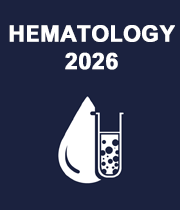Title : Anicteric veno-occlusive disease
Abstract:
Hepatic veno-occlusive disease (VOD) / sinusoidal obstruction syndrome (SOS) is a mortal disease being seen in Hematopoietic Stem Cell Transplantation (HSCT). It was seen in almost 14% of all HSCT cases (adult and pediatric) and 30% in pediatric patients. Whereas anicteric VOD was seen in 15% of adult cases, and 29% in pediatric cases.
The veno-occlusive disease causes multiorgan failure that may result in over 80% of mortality. Because of this reason early diagnosis and treatment of VOD are very important
Risk Factors: There are some risk factors determined after HSCT as follows:
1-Transplant-related risk factors: allogeneic HSCT, unrelated donor, HLA-mismatch donor, myeloablative conditioning regimen, busulfan-based conditioning regimen, total body irradiation (TBI) -based conditioning regimen, non-T-cell depletion graft, second HSCT, using sirolimus, methotrexate, and cyclophosphamide for graft versus host disease (GVHD)
2-Disease and disease-related risk factors: over 4 years old and adult patients, using norethisterone, the patients who had lower than 90% of Karnofsky score, gen polimorfizim ( such as GSTM1, GSMTT1, heparanase), advanced disease (second CR or relapse), metabolic disease, deficiency of AT III, t-PA or active protein C resistance, thalassemia patients
3-Hepatic risk factors: higher transaminase level (over 2,5 times normal level), higher bilirubin level (over 1,5 times normal level), cirrhosis, hepatic fibrosis, active viral hepatitis, hepatic irradiation, previous using of gemtuzumab ozogamisin, using of hepatotoxic drugs, iron overload (1).
Pathogenesis: Sinus endothelium injury by toxic metabolites is the main cause of VOD. After this injury, a local inflammatory response occurs. Activation of the coagulation system and fibrinolytic system occurred subsequently. In the advanced stage of this events will end with hepatic necrosis. Out of sinus endothelium, hepatocyte that settles in sinus endothelium was also injured. Because of the damage to sinus endothelium, endothelium cells begin to separate from each other, and cell and cell debris begin to move to the Disse spaces. This obstructs the venous lumen and portal hypertension occurs. As a result; hepatic necrosis and centrilobular hemorrhagic necrosis have occurred. Local cytokines and coagulation cascade affect all these events (1).
Clinic Findings: Weight gain, volüme overload (acid), painful hepatomegaly, icterus, and multiorgan failure (pulmonary and renal failure and encephalopathy) are the clinical findings that were seen in classic VOD. Classical VOD has mostly seen in the first 3 weeks after HSCT and 15-20% of classical VOD was seen after the first 3 weeks of HSCT.
Criteria Used in Diagnosis: Baltimore criteria and modified Seattle criteria have been used to diagnose classical VOD until recent years. Europen Bone Marrow Transplantation (EBMT) criteria have been determined for pediatric and adult patients. A high bilirubin level is the mandatory criterion in Baltimore criteria, however, a high bilirubin level is not a mandatory criterion in Seattle criteria. For the EBMT criteria first 21 days of HSCT high bilirubin level is a mandatory criterion, after the first 21 days high bilirubin level is not mandatory (2,3,4,5).
Baltimore Criteria (2):
1- Bilirubin level > 2 mg/dl (mandatory)
2- Wieght gain (bazal level > 5%)
3- Hepatomegaly
4- Acid
Seattle Criteria (3):
1- Bilirubin level > 2 mg/dl
2- Acid or weight gain (basal level > 2%)
3- Hepatomegaly and right upper pain in the abdomen
Two of the three criteria should be positive till +20 days of HSCT
EBMT Criteria (4,5):
Classical VOD is seen in the first 21 days after HSCT. Bilirubin level should be ?2 mg/dL and include two of the following criteria:
1-Painful hepatomegaly
2-Weight gain >5%
3-Acid
Delayed VOD occurs more than 21 days after HSCT. It is defined as classic signs of VOD lasting more than 21 days or histological evidence of VOD or two or more of the following criteria:
1-Bilirubin level ?2 mg/dL
2-Painful hepatomegaly
3-Weight gain >5%
4-Ascites and hemodynamic and/or presence of VOD as an ultrasound finding
There are some differences in EBMT criteria between adult and pediatric patients: resistant thrombocytopenia is among the VOD criteria for pediatric patients, this condition is not present for adults, bilirubin elevation is mandatory for the first 21 days after HSCT for adults, late-onset VOD seen after 21 days and high bilirubin level is not mandatory, and there is no time limit opposite of pediatric patients criteria.
In recent years, it has been emphasized that the high level of bilirubin is mostly related to the severity of VOD. Mohty et al. determined the severity of VOD in 2016 (5). Accordingly, patients can be graded as mild, moderate, severe, and very severe according to their bilirubin levels, transaminase levels, weight gain, and renal function. Especially in this grading system, bilirubin kinetics were also taken into account. Cases with a doubling at bilirubin level in 48 hours should be considered as cases with severe VOD (5).
While diagnosing VOD, liver biopsy, and ultrasonography are also used (6). A liver biopsy is a gold standard for the diagnosis of VOD. However, it is not preferred because of thrombocytopenia and coagulopathy. Ultrasonographically, splenomegaly and ascites are seen, and monitoring of flow towards the paraumbilical vein on Doppler ultrasound indicates the severity of VOD. Reversal of portal venous flow is a demographic finding, but it is seen in the late period of VOD (6).
How is anicteric VOD defined?
Myers et al. drew attention to the fact that bilirubin values were below 2 mg/dl in 5 cases with VOD that they reported in 2015 (7). In these cases, the reverse portal venous flow was seen ultrasonographically. In this case series in the literature, patients have all the features of VOD, however, bilirubin elevation was not observed (7). Anicteric VOD is defined as; those who were diagnosed with VOD and had other criteria for VOD, but had a bilirubin level below 2 mg/dl and did not exceed 2 mg/dl in the follow-ups (8,9). In the survey conducted by Skeens et al. in 2016 with the participation of four countries (physicians and healthcare professionals from America, Canada, Australia, and England), it was stated that 40% of the participants had never had a patient who diagnosis of anicteric VOD (10). The remaining 60% of the participants had patients who had an anicteric VOD diagnosis; perhaps anicteric VOD may be in substantial numbers above the rates reported in the literature. In the same year, Naples et al. reported that 20 of 29 patients had classical VOD (69%), and 9 patients (31%) had anicteric VOD (11). Naples et al; did not accept the elevation of the bilirubin and the presence of return flow in the portal vein on Doppler ultrasound as a condition for the diagnosis of VOD (11). Although it is thought that anicteric VOD is mostly seen in children and if it is seen in adults, it is seen in the days after first 21 days after HSCT; In the article published by Corbacioglu et al. in 2020: it was emphasized that anicteric VOD can be seen as frequently in adults as in children and can be seen in the first 21 days after HSCT (12). At the same time, in this study, it was shown that bilirubin elevation is more related to the severity of the disease in VOD and that the survival of those with anicteric VOD at the 100th day after HSCT is better than those with icteric VOD (12).
In the study by Mehra et al. presented in 2021 based on real-life data, those with anicteric VOD were included in the patients with late-onset VOD (13). They noticed that only 2 of the 27 patients with VOD had anicteric VOD, and it was reported that these two patients were seen after the 21st day after HSCT (13). As mentioned before, bilirubin elevation in the first 21 days is an absolute condition in the EBMT criteria, like the Baltimore criteria, but some patients may have resistant thrombocytopenia (42% of those with classic VOH for this study) and bilirubin elevation may not be seen in the first 21 days. These patients may be diagnosed with VOD. Therefore, the question arises whether the EBMT criteria should include resistant thrombocytopenia for adults as well as for children. The study published by Mohty et al. in 2022 is on patients receiving defibrotide treatment (14). One hundred and four patients were included in the study; 42 (40%) patients had mild/moderate VOD and 62 (60%) patients had severe VOD. The primary endpoint of the study was: the determination of the defibrotide side-
effect profile; the secondary endpoint: was the determination of the VOD recovery rate and 100-day survival. The mean time to start defibrotide with the diagnosis of VOD was day 0 (days 0-11). Only 30 (29%) of the patients included in the study had anicteric VOD. It has been stated that anicteric VOD is seen at higher rates in pediatric patients, and when the total patient rate is considered, it has been observed that anicteric cases are at a substantial level, constituting 1/3 of the patients. There was no difference between the two groups in terms of the defibrotide side effect profile. Considering the secondary endpoint of disease recovery and 100-day survival analysis; it has been observed that patients with anicteric VOD are more advantageous than those with classical VOD (14).
To summarize; While classical VOD is a complication that can be fatal with an aggressive course, anicteric VOD is a complication that has the characteristics of classical VOD but has a bilirubin level below 2 mg/dl and a milder course than classical VOD. Compared to classical VOD, there is no time limitation. However, in most of the studies in the literature, it was emphasized that it may occur after 21 days after HSCT. While it is more common in pediatric patients, it should not be forgotten that it can be seen in adults as well. Baltimore criteria are restrictive because they require high bilirubin. While the modified Seattle criteria have more flexible features in anicteric VOD diagnosis, the EBMT criteria seem more ideal than the other two diagnostic criteria. However, it is controversial because the elevation of the bilirubin level is mandatory in the first 21 days after HSCT and does not include the criteria for resistant thrombocytopenia.



